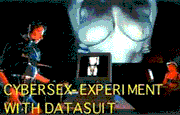2.7.3 The Datadandy: Virtual Identity in the Nineties
 Whereas the 80s were dominated by the Cyberpunk as a high-tech
low life terminal-identity, with its connotations of underground,
illegality, counterculture and computernerd, in the 90s more widespread
virtual identities take over.
Whereas the 80s were dominated by the Cyberpunk as a high-tech
low life terminal-identity, with its connotations of underground,
illegality, counterculture and computernerd, in the 90s more widespread
virtual identities take over.
Timothy Leary describes them as a new generation which he calls the 'New Breed', informed, open-minded and irreverent 'reality pilots', who are concerned about the 'invention of a personal style', accept complexity in their cosmic view and are willing to become 'chaos designers.' (compare Leary 1994: 81) This New Breed takes therefore his basic theme of 'Think for yourself, question authorities'
Rob Shields uses similar attributes, in playing around with the notion of 'Cyberpunk Cinderella': "internet and other cyberspaces are imagined as a three dimensional space which can be flown or strolled through like a mid-nineteenth century flaneur might have explored the arcades and department stores of Paris in a state of fascinated distraction." (Tester quoted by WWW: Cyberpunk Cinderella)
When the textbased culture of the net in form of MUDs, IRC and gopher becomes replaced through the graphical WWW, video-conferencing and graphical MUDs with avatars, aesthetics wins over communication. "We left behind the stage of pioneers, now it is all about the grace of the medial gesture." (Bilwet 1994: 78 - transl. S.J.)
Bilwet therefore demands: 'Away with the rural NASA-aesthetics of the cybernauts.' We left the 'garage-romantics' of the 80s behind. In the 90s the figure of the 'Datadandy' is taking over: "The datadandy collects information only to boast about them, not to transfer them." (ibid.: 75- transl. S.J.) "The Datadandy views his avatar in cyberspace as the centre of the digital cosmos. [..] He views the net as space for his own show, not as space for communication. The simulation is the foundations of his 'General Principles of Digital Elegance', that become rejected as 'desire for decline' or 'pure hedonism' from essentialists who still believe in the difference between real and unreal." (ibid.: 76 -transl. S.J.) "The infodandy knows, that he is never more than one madman in between the many madmen in the carnival of changeability of the information-circus." (ibid.: 79- transl. S.J.)
![]()